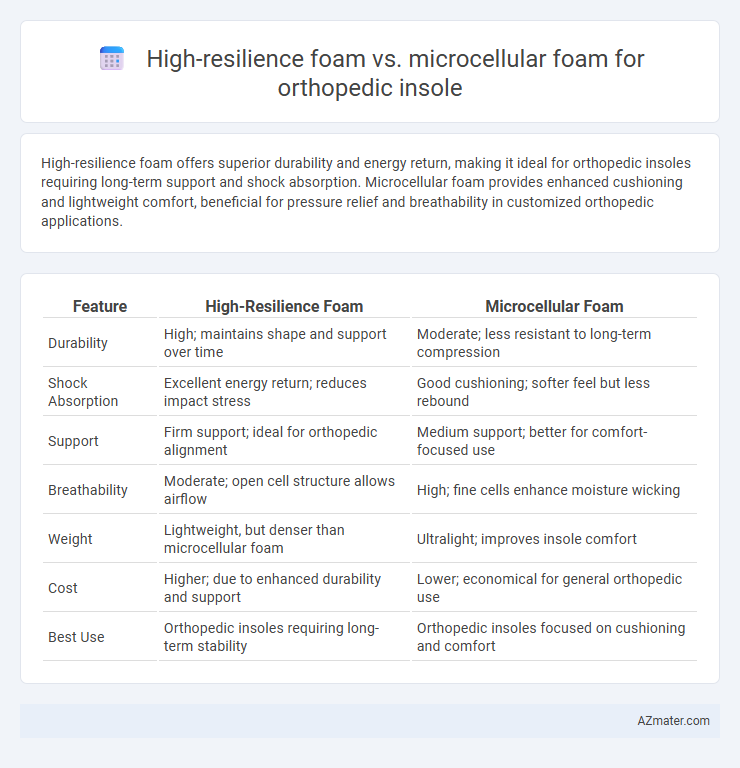High-resilience foam offers superior durability and energy return, making it ideal for orthopedic insoles requiring long-term support and shock absorption. Microcellular foam provides enhanced cushioning and lightweight comfort, beneficial for pressure relief and breathability in customized orthopedic applications.
Table of Comparison
| Feature | High-Resilience Foam | Microcellular Foam |
|---|---|---|
| Durability | High; maintains shape and support over time | Moderate; less resistant to long-term compression |
| Shock Absorption | Excellent energy return; reduces impact stress | Good cushioning; softer feel but less rebound |
| Support | Firm support; ideal for orthopedic alignment | Medium support; better for comfort-focused use |
| Breathability | Moderate; open cell structure allows airflow | High; fine cells enhance moisture wicking |
| Weight | Lightweight, but denser than microcellular foam | Ultralight; improves insole comfort |
| Cost | Higher; due to enhanced durability and support | Lower; economical for general orthopedic use |
| Best Use | Orthopedic insoles requiring long-term stability | Orthopedic insoles focused on cushioning and comfort |
Introduction to Orthopedic Insoles: Importance of Material Choice
High-resilience foam and microcellular foam are critical materials in the design of orthopedic insoles, directly affecting comfort, support, and durability. High-resilience foam offers superior cushioning and energy return, making it ideal for high-impact absorption in orthopedic applications, while microcellular foam provides enhanced shock absorption and breathability due to its fine-cell structure. Selecting the appropriate foam material is essential for optimizing pressure distribution and reducing foot pain in orthopedic patients.
What is High-Resilience Foam? Key Properties and Benefits
High-resilience foam is a durable polyurethane material characterized by its excellent energy return, superior elasticity, and long-lasting cushioning, making it ideal for orthopedic insoles designed to provide consistent support and shock absorption. Key properties include high tensile strength, open-cell structure for breathability, and resistance to deformation under repeated stress, which helps maintain foot alignment and reduce fatigue. Benefits of high-resilience foam in orthopedic applications include enhanced comfort, improved pressure distribution, and durability, supporting patients with chronic foot conditions or those requiring extended wear.
Understanding Microcellular Foam: Structure and Advantages
Microcellular foam features a uniform structure with tiny, closed cells that provide enhanced cushioning and durability compared to high-resilience foam, which has larger, open cells for greater bounce and responsiveness. The microcellular design offers superior shock absorption and pressure distribution, making it ideal for orthopedic insoles that require consistent support and comfort. Its resilient yet flexible nature helps reduce foot fatigue and improve overall biomechanical efficiency in orthopedic applications.
Cushioning and Shock Absorption Comparison
High-resilience foam offers superior cushioning and shock absorption due to its high density and elasticity, effectively distributing pressure and reducing foot fatigue in orthopedic insoles. Microcellular foam provides lightweight comfort with moderate cushioning, featuring a finer cell structure that enhances breathability but may compress faster under sustained loads. For optimal orthopedic support, high-resilience foam is preferred for durability and impact resistance, while microcellular foam suits scenarios prioritizing softness and airflow.
Durability and Longevity in Daily Use
High-resilience foam offers superior durability and maintains its cushioning properties over extended daily use, making it ideal for orthopedic insoles requiring long-term support. Microcellular foam provides excellent initial comfort and shock absorption but tends to compress faster, potentially reducing the insole's lifespan. For orthopedic applications demanding consistent performance and longevity, high-resilience foam is generally preferred due to its enhanced structural integrity and resilience against wear.
Comfort Levels: High-Resilience vs Microcellular Foam
High-resilience foam offers superior cushioning and energy return, enhancing comfort during prolonged use in orthopedic insoles. Microcellular foam provides a softer, more adaptive feel with excellent pressure distribution, ideal for sensitive feet requiring gentle support. Comparing comfort levels, high-resilience foam suits active users needing durability, while microcellular foam favors those prioritizing softness and shock absorption.
Breathability and Moisture Management
High-resilience foam offers superior breathability due to its open-cell structure, promoting effective airflow and reducing heat buildup in orthopedic insoles. Microcellular foam, while providing good cushioning, has a denser cell structure that limits ventilation and can retain moisture, impacting overall moisture management. For enhanced comfort and hygiene, high-resilience foam excels in maintaining dryness and preventing odor caused by sweat accumulation.
Customization Potential for Orthopedic Needs
High-resilience foam offers superior customization potential for orthopedic insoles due to its excellent energy return and durability, allowing precise molding to diverse foot shapes and pressure points. Microcellular foam, while lightweight and breathable, provides less structural support and may compress over time, limiting long-term customizability for individual orthopedic requirements. Selecting high-resilience foam enhances personalized support, critical for managing conditions like plantar fasciitis and diabetic foot ulcers.
Cost Analysis: High-Resilience vs Microcellular Foams
High-resilience foam typically offers better durability and support at a moderate cost, making it a cost-effective choice for orthopedic insoles designed for long-term use. Microcellular foam, while often more expensive due to its advanced cushioning properties and finer cell structure, provides superior comfort and impact absorption that can justify the higher investment in specialized or high-performance applications. Evaluating the total cost of ownership involves balancing initial material expenses with the expected lifespan and patient comfort benefits for optimized orthopedic insole solutions.
Choosing the Right Foam for Orthopedic Insoles: Final Recommendations
High-resilience foam offers superior support and durability for orthopedic insoles, making it ideal for patients requiring high-impact absorption and long-lasting comfort. Microcellular foam provides enhanced cushioning and flexibility, suitable for individuals seeking lightweight and adaptive insoles with moderate support. Selecting the right foam depends on factors such as patient activity level, weight distribution needs, and orthopedic condition severity to optimize insole performance and foot health.

Infographic: High-resilience foam vs Microcellular foam for Orthopedic insole
 azmater.com
azmater.com